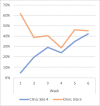The impact of pulse oximetry and Integrated Management of Childhood Illness (IMCI) training on antibiotic prescribing practices in rural Malawi: A mixed-methods study
- PMID: 33211744
- PMCID: PMC7676725
- DOI: 10.1371/journal.pone.0242440
The impact of pulse oximetry and Integrated Management of Childhood Illness (IMCI) training on antibiotic prescribing practices in rural Malawi: A mixed-methods study
Abstract
Background: The misdiagnosis of non-malarial fever in sub-Saharan Africa has contributed to the significant burden of pediatric pneumonia and the inappropriate use of antibiotics in this region. This study aims to assess the impact of 1) portable pulse oximeters and 2) Integrated Management of Childhood Illness (IMCI) continued education training on the diagnosis and treatment of non-malarial fever amongst pediatric patients being treated by the Global AIDS Interfaith Alliance (GAIA) in rural Malawi.
Methods: This study involved a logbook review to compare treatment patterns between five GAIA mobile clinics in Mulanje, Malawi during April-June 2019. An intervention study design was employed with four study groups: 1) 2016 control, 2) 2019 control, 3) IMCI-only, and 4) IMCI and pulse oximeter. A total of 3,504 patient logbook records were included based on these inclusion criteria: age under five years, febrile, malaria-negative, and treated during the dry season. A qualitative questionnaire was distributed to the participating GAIA providers. Fisher's Exact Testing and odds ratios were calculated to compare the prescriptive practices between each study group and reported with 95% confidence intervals.
Results: The pre- and post-exam scores for the providers who participated in the IMCI training showed an increase in content knowledge and understanding (p<0.001). The antibiotic prescription rates in each study group were 75% (2016 control), 85% (2019 control), 84% (IMCI only), and 42% (IMCI + pulse oximeter) (p<0.001). An increase in pneumonia diagnoses was detected for patients who received pulse oximeter evaluation with an oxygen saturation <95% (p<0.001). No significant changes in antibiotic prescribing practices were detected in the IMCI-only group (p>0.001). However, provider responses to the qualitative questionnaires indicated alternative benefits of the training including improved illness classification and increased provider confidence.
Conclusion: Clinics that implemented both the IMCI course and pulse oximeters exhibited a significant decrease in antibiotic prescription rates, thus highlighting the potential of this tool in combatting antibiotic overconsumption in low-resource settings. Enhanced detection of hypoxia in pediatric patients was regarded by clinicians as helpful for identifying pneumonia cases. GAIA staff appreciated the IMCI continued education training, however it did not appear to significantly impact antibiotic prescription rates and/or pneumonia diagnosis.
Conflict of interest statement
The authors have declared that no competing interests exist.
Figures





Similar articles
-
Integrated paediatric fever management and antibiotic over-treatment in Malawi health facilities: data mining a national facility census.Malar J. 2016 Aug 4;15(1):396. doi: 10.1186/s12936-016-1439-7. Malar J. 2016. PMID: 27488343 Free PMC article.
-
Determinants of Integrated Management of Childhood Illness (IMCI) non-severe pneumonia classification and care in Malawi health facilities: Analysis of a national facility census.J Glob Health. 2017 Dec;7(2):020408. doi: 10.7189/jogh.07.020408. J Glob Health. 2017. PMID: 29163934 Free PMC article.
-
'Not all fevers are malaria': a mixed methods study of non-malarial fever management in rural southern Malawi.Rural Remote Health. 2019 Jun;19(2):4818. doi: 10.22605/RRH4818. Epub 2019 Jun 15. Rural Remote Health. 2019. PMID: 31200600
-
The integrated management of childhood illness (IMCI) and its potential to reduce the misuse of antibiotics.J Glob Health. 2021 May 22;11:04030. doi: 10.7189/jogh.11.04030. J Glob Health. 2021. PMID: 34055327 Free PMC article. Review.
-
Integrated Management of Childhood Illness (IMCI): a robust strategy.Indian J Pediatr. 2002 Jan;69(1):41-8. doi: 10.1007/BF02723776. Indian J Pediatr. 2002. PMID: 11876120 Review.
Cited by
-
Development and validation of a novel clinical risk score to predict hypoxaemia in children with pneumonia using the WHO PREPARE dataset.BMJ Glob Health. 2025 Jul 7;10(7):e017256. doi: 10.1136/bmjgh-2024-017256. BMJ Glob Health. 2025. PMID: 40623791 Free PMC article.
-
Pulse oximetry in pediatric care: Balancing advantages and limitations.World J Clin Pediatr. 2024 Sep 9;13(3):96950. doi: 10.5409/wjcp.v13.i3.96950. eCollection 2024 Sep 9. World J Clin Pediatr. 2024. PMID: 39350904 Free PMC article.
-
Community health worker and caregiver experiences and perceptions of a multimodal handheld pulse oximeter used in sick child consultations in rural Burundi: A qualitative evaluation.PLOS Glob Public Health. 2025 Jan 13;5(1):e0002399. doi: 10.1371/journal.pgph.0002399. eCollection 2025. PLOS Glob Public Health. 2025. PMID: 39804948 Free PMC article.
-
Pulse oximetry training landscape for healthcare workers in low- and middle-income countries: A scoping review.J Glob Health. 2023 Sep 22;13:04074. doi: 10.7189/jogh.13.04074. J Glob Health. 2023. PMID: 37736848 Free PMC article.
-
Pulse oximeter provision and training of non-physician anesthetists in Zambia: a qualitative study exploring perioperative care after training.BMC Health Serv Res. 2022 Nov 23;22(1):1395. doi: 10.1186/s12913-022-08698-5. BMC Health Serv Res. 2022. PMID: 36419106 Free PMC article.
References
-
- Ministry of Health—National Malaria Control Program. Malawi Malaria Indicator Survey [Internet]. 2017 [cited 2018 Nov 19]. Available from: https://dhsprogram.com/pubs/pdf/MIS28/MIS28.pdf
-
- Black RE, Cousens S, Johnson HL, Lawn JE, Rudan I, Bassani DG, et al. Global, regional, and national causes of child mortality in 2008: a systematic analysis. Lancet [Internet]. 2010. June 5 [cited 2018 Nov 19];375(9730):1969–87. Available from: http://www.ncbi.nlm.nih.gov/pubmed/20466419 10.1016/S0140-6736(10)60549-1 - DOI - PubMed
-
- Malawi Ministry of Health. Malawi Child Health Strategy for Survival and Health Development of Under-five Children in Malawi 2014–2020. Lilongwe, Malawi; 2013.
Publication types
MeSH terms
Substances
LinkOut - more resources
Full Text Sources
Medical
Miscellaneous

